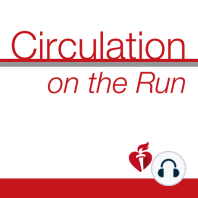18 min listen
Circulation March 17, 2020 Issue
ratings:
Length:
22 minutes
Released:
Mar 16, 2020
Format:
Podcast episode
Description
Dr Carolyn Lam: Welcome to Circulation on the Run, your weekly podcast summary and backstage pass to the journal and its editors. I'm Dr Carolyn Lam, associate editor from the National Heart Center and Duke National University of Singapore. Dr Greg Hundley: I'm Dr Greg Hundley from the Pauley Heart Center at VCU Health in Richmond, Virginia. Dr Carolyn Lam: Greg, this issue features a very important, but rather somber subject and it talks about suicide attempts among LVAD recipients and the real-life data from the Assist-ICD study. Now we have to get to that and it's a very interesting discussion, but first, let's discuss a couple of papers and I'll start. Now, we know that extracorporeal cardiopulmonary resuscitation using extracorporeal membrane oxygenation or ECMO, for hemodynamic support has been shown to enhance survival for patients with refractory VF or VT out of hospital cardiac arrest. However, what are the effects of prolonged CPR on development of metabolic derangements and neurologically favorable survival in these patients? Well, this was examined by Dr Bartos from University of Minnesota School of Medicine and colleagues who retrospectively evaluated survival in 160 consecutive adults with refractory VF/VT out of hospital cardiac arrest, treated with extracorporeal cardiopulmonary resuscitation, and compared these with 654 adults who had received standard CPR in the amiodarone arm of the ALPS trial. They found that extracorporeal CPR was associated with improved neurologically favorable survival compared to standard CPR at all CPR durations less than 60 minutes. However, CPR duration remained a critical determinant of survival with a 25% increase in mortality with every 10 minutes of CPR beyond 30 minutes. The progressive metabolic derangement which developed during prolonged CPR was associated with reduced neurologically favorable survival. Dr Greg Hundley: This mirrors an article that we had maybe about a month ago. What are the clinical implications of this particular study? Dr Carolyn Lam: Well, healthcare systems utilizing extracorporeal CPR for out of hospital cardiac arrest should optimize pre-hospital and in-hospital processes to minimize time to CPR. Further research is needed to identify strategies to increase CPR efficiency, improve profusion, and decrease the metabolic demands such that the progressive metabolic derangement associated with prolonged CPR can be delayed. This is discussed in an editorial by Dr Sonneville and Schmidt. Dr Greg Hundley: Very nice, Carolyn. Well, my next article is from Roxana Mehran from the Icahn School of Medicine at Mount Sinai. It's really getting at the issue of high-risk implantation of inter-coronary stents and balancing where is that risk. Is it from bleeding or a complication from the procedure? In this study, they had a total of 10,502 patients and they were included from four registries. 3,507 were identified as having high bleeding risk. The authors aimed to evaluate the long-term adverse events in the high bleeding risk patients undergoing PCI with cobalt chromium, everolimus-eluting stent implantation. Dr Carolyn Lam: Ah, Greg. Awesome. I'm a fan of Dr Mehran and looks like I'm going to be a fan of this study. What did they find? Dr Greg Hundley: Well, Carolyn, I love just thinking about coated stents. How about that? Interestingly, those at high bleeding risk had more comorbidities. They had higher lesion complexity and a higher risk of four-year mortality. In fact, four times that of those without those risk factors. The risk of mortality was increased after coronary thrombotic events and after major bleeding. Thus, rather than just being evaluated as a subset of patients in whom the risk of bleeding takes precedence, high bleeding risk patients must be considered a vulnerable population in whom both ischemic as well as bleeding events have a significant impact on their mortality. Dr Carolyn Lam: Nice, Greg, and you said all of that without repeating ever
Released:
Mar 16, 2020
Format:
Podcast episode
Titles in the series (100)
Circulation January 23, 2018 Issue by Circulation on the Run
